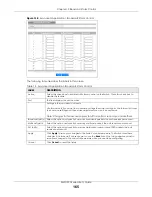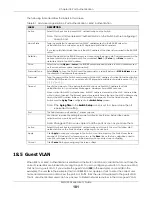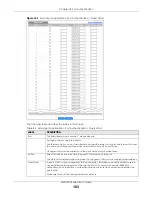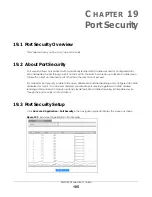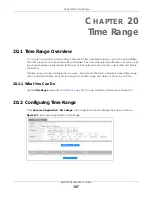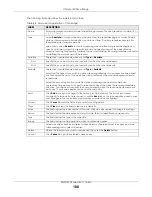
Chapter 18 Port Authentication
XMG1930 Series User’s Guide
176
C
HAPTER
18
Port Authentication
18.1 Port Authentication Overview
This chapter describes the IEEE 802.1x, MAC, and Guest VLAN authentication methods.
Port authentication is a way to validate access to ports on the Switch to clients based on an external
authentication server. The Switch supports the following methods for port authentication:
•
IEEE 802.1x
2
– An authentication server validates access to a port based on a user name and
password provided by the user. A user that fails an authentication server can still access the port, but
traffic from the user is forwarded to the guest VLAN port.
•
MAC Authentication
– An authentication server validates access to a port based on the MAC address
and password of the client.
•
Guest VLAN
– In either mode, if authentication fails the Switch can still allow the client to access the
network on a
Guest VLAN
.
Note: All types of authentication use the RADIUS (Remote Authentication Dial In User Service,
RFC 2138, 2139) protocol to validate users. You must configure a RADIUS server before
enabling port authentication.
Note: If you enable IEEE 802.1x authentication and MAC authentication on the same port, the
Switch performs IEEE 802.1x authentication and MAC authentication. If a user fails to
authenticate either through the IEEE 802.1x or MAC authentication method, then
access to the port is denied.
Note: IEEE 802.1x is not supported by all user operating systems. For details on compatibility,
see your operating system documentation. If your operating system does not support
802.1x, you must install 802.1x client software.
18.1.1 What You Can Do
• Use the
Port Authentication
screen (
) to display the links to the configuration
screens where you can enable the port authentication methods.
• Use the
802.1x
screen (
) to activate IEEE 802.1x security.
• Use the
MAC Authentication
) to activate MAC authentication.
• Use the
Guest Vlan
screen (
) to enable and assign a guest VLAN to a port.
2.
At the time of writing, IEEE 802.1x is not supported by all operating systems. See your operating system
documentation. If your operating system does not support 802.1x, then you may need to install 802.1x
client software.




